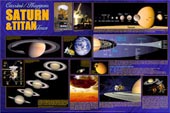


|

|
|
|
Hovering over Titan CASSINI PHOTO RELEASE Posted: November 24, 2004 A mosaic of nine processed images recently acquired during Cassini's first very close flyby of Saturn's moon Titan on Oct. 26, 2004, constitutes the most detailed full-disc view of the mysterious moon.
The images that comprise the mosaic have been processed to reduce the effects of the atmosphere and to sharpen surface features. The mosaic has been trimmed to show only the illuminated surface and not the atmosphere above the edge of the moon. The Sun was behind Cassini so nearly the full disc is illuminated. Pixels scales of the composite images vary from 2 to 4 kilometers per pixel (1.2 to 2.5 miles per pixel). Surface features are best seen near the center of the disc, where the spacecraft is looking directly downwards; the contrast becomes progressively lower and surface features become fuzzier towards the outside, where the spacecraft is peering through haze, a circumstance that washes out surface features. The brighter region on the right side and equatorial region is named Xanadu Regio. Scientists are actively debating what processes may have created the bizarre surface brightness patterns seen here. The images hint at a young surface with, no obvious craters. However, the exact nature of that activity, whether tectonic, wind-blown, fluvial, marine, or volcanic is still to be determined. The images comprising this mosaic were acquired from distances ranging from 650,000 kilometers (400,000 miles) to 300,000 kilometers (200,000 miles). The Cassini-Huygens mission is a cooperative project of NASA, the European Space Agency and the Italian Space Agency. The Jet Propulsion Laboratory, a division of the California Institute of Technology in Pasadena, manages the Cassini-Huygens mission for NASA's Office of Space Science, Washington, D.C. The Cassini orbiter and its two onboard cameras, were designed, developed and assembled at JPL. The imaging team is based at the Space Science Institute, Boulder, Colo. |
|
|
|
Cassini poster Just in time for the Cassini spacecraft's arrival at Saturn, this new poster celebrates the mission to explore the ringed planet and its moons. Just in time for the Cassini spacecraft's arrival at Saturn, this new poster celebrates the mission to explore the ringed planet and its moons.2005 Calendar  The 2005 edition of the Universe of the Hubble Space Telescope calendar is available from our U.S. store and will soon be available worldwide. This 12x12-inch calendar features spectacular images from the orbiting observatory. The 2005 edition of the Universe of the Hubble Space Telescope calendar is available from our U.S. store and will soon be available worldwide. This 12x12-inch calendar features spectacular images from the orbiting observatory.Moon panorama  Taken by Apollo 14 commander Alan Shepard, this panoramic poster shows lunar module pilot Edgar Mitchell as a brilliant Sun glare reflects off the lunar module Antares. Taken by Apollo 14 commander Alan Shepard, this panoramic poster shows lunar module pilot Edgar Mitchell as a brilliant Sun glare reflects off the lunar module Antares.Mars Rover mission patch  A mission patch featuring NASA's Mars Exploration Rover is now available from the Astronomy Now Store. A mission patch featuring NASA's Mars Exploration Rover is now available from the Astronomy Now Store. |
|||||||||||||||||||||